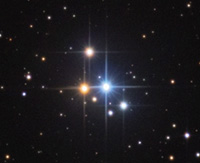Stars that are on the main sequence fuse hydrogen to helium in their cores. Main sequence stars are brighter and bluer the more massive they are, and fainter and redder the more lightweight they are.
When moderately massive stars have used up the hydrogen in their cores, they turn into red giants. These stars become cooler but also much larger than they were before, when they turn into red giants. They also become brighter than they were before.
Very massive stars turn into supergiants. Supergiants come in all colors, from blue to red. Supergiants are typically more or less the same brightness, although there are certainly some that are "extra extremely bright".
The more massive a star is, the sooner it evolves off the main sequence and becomes a giant or a supergiant.
Let's look at two typical clusters.
The cluster at left is the Beehive Cluster in Cancer. You can see that it is a relatively sparse cluster. The stars are only moderately bright. The blue-white stars are main sequence stars of spectral class A, similar to Sirius, and the yellow stars are moderately bright giants of spectral class K. In short, this is a moderate-mass cluster, and its stars are not very luminous and not very brightly colored.
At right you can see the Double Cluster in Perseus. As you can see, the clusters are very rich. Because the clusters are rich, they are also very massive. We expect such very rich clusters to contain some very massive stars if they are still young, and these clusters are, and do: There are supergiant blue stars here of spectral class B, and supergiant red stars here of spectral class M.
Now let's look at two clusters or stellar groupings and try to use their colors to guess if they are related.
31 Cygni (bright orange star and very blue star below it),
and 30 Cygni (blue-white star to the upper right).
Photo: Jerry Lodriguss.
and 30 Cygni (blue-white star to the upper right).
Photo: Jerry Lodriguss.
The intensely blue star below the orange giant is a B-type star. Its B-V index is -0.13, which is really quite blue. This star is much fainter than the orange giant. It may or may not itself be an evolved star, but whether or not it is, it is still hot, and it is almost certainly less massive than the orange star. And we do expect the most massive stars to evolve into giants before the less massive stars. In short, the orange and the blue star make a "reasonable" pair.
Now look at 30 Cygni, the blue-white star to the upper right of the orange giant. It looks definitely less blue than the blue star closer to the orange star. And it really is less blue. Its B-V index is +0.10, a noticeable difference.
30 Cygni does not seem to belong to the two stars that make up 31 Cygni. It seems to be closer to us (although its Hipparcos parallax is very uncertain), and its proper motion is different. The spectral class of 30 Cygni is A5III, meaning it is an evolved giant. It is still moderately hot, or at least it is not yet a cool giant.
Now let's look at NGC 2017! It is a small group of stars, and its brightest member is noticeably bluer than the rest. It is a star of spectral class B4, with a B-V index of -0.09.
Most curiously, there is a very orange star to the left of the bright blue one that is fainter than the blue luminary. We don't expect that. The most massive stars turn into giants first, and then they get brighter, not fainter. What's going on?
Well, the red star just might be a background object. We don't know for sure, even though Gaia could tell us. Working with Hipparcos, though, we can say that the red star appears to be even farther away than the blue star, and it appears to have a different proper motion. So it might be a background object. Its B-V, by the way, is +1.50.
To the upper right of the bright blue star is a beige-colored object. This might be an F-type star, and not just that: It might be a main sequence F-type star! The blue and the orange stars are probably hundreds of times brighter than the Sun. The F-type star might be ~ 8 times brighter than the Sun! It is clearly a foreground object. Its B-V is +0.45.
How weird. In this small cluster, we may have three seeming cluster members that are at wildly different distances from us. If this is true, cluster NGC 2017 is not a cluster at all.
This picture by Donald Pelletier gives you a better idea of the relative apparent brightnesses of the stars in NGC 2017, although I think it does a worse job in bringing out the colors. Colors can tell you a lot about stars.
Ann


